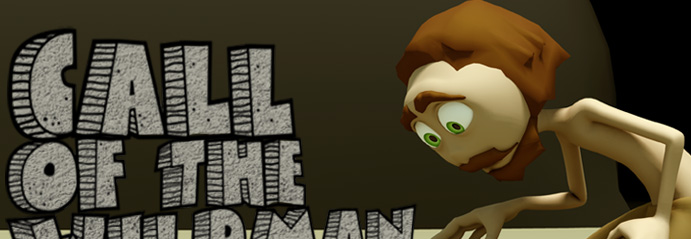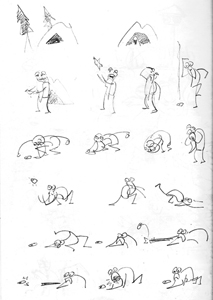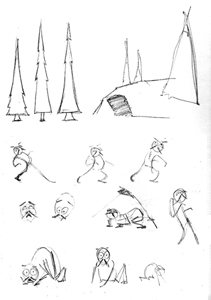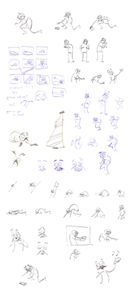
|
|
|
|
|
|

|
|
|
|

|
|
|
|
|
|
|
|
Animation Mentor: How did you come up with the concept for your short film?
Thomas Lubanovic: The idea of a phone falling out of the sky popped into my head one day when I was leaving work. It was a pretty basic idea, the rest of the story took quite a while to build up and figure itself out. Animation Mentor: What important lessons did you learn from making your short film?
Thomas Lubanovic: Revisions really were an important lesson. There was a section of animation I completely redid, when the Wildman jumps down out of the tree. He originally landed and skidded across the ground, but my mentor Ethan Hurd suggested I could make it look much more natural by having him bounce and settle. This was getting close to the end of our production schedule, but I made the changes and it absolutely made the film better. Animation Mentor: What was the best piece of advice you received from your mentor or your peers?
Thomas Lubanovic: And so, when I was invited by some friends, I went on a huge road trip in the middle of production for my film, from Minnesota to Arizona and back. I was still animating, sometimes on the road on a laptop in the backseat, or when we stopped at hotels. It was a good way to get inspired and test myself. Also, I didn't know when I'd get another chance to visit the Southwest. We saw the Grand Canyon at sunrise and I managed to get all my shots finished. Animation Mentor: What were the steps you took in your planning process?
Thomas Lubanovic: Another important step during planning was getting the environment and set created for layout. I knew I wanted to keep it simple, so I made everything very geometric with rounded edges. The trees and nest and cell phone and Wildman all had to look like part of the same world. Planning for animation was a combination of drawing poses, acting them out and looking around YouTube. It was a good excuse to watch a lot of dumb cat videos. In the first half of the film, most of the poses are loosely based on some type of animal reference. Animation Mentor: Do you mind sharing some of the pre-production work with us with a little explanation of what we're looking at? Thomas Lubanovic: These are some of the first thumbnails I did, a starting point for my character and the story. As I went through different ideas, I eventually settled on something more like this. The Wildman is more animal-like and I was happy with this kind of simple environment for him to be in. I did lots and lots of drawings to help myself figure out what I was doing, even late into production. This made animating so, so much easier. This was my final pitch for the story idea. I recommend spitting out your gum when you do this. The ending was very, very different at this point. Something I kind of liked, but not quite the character arc I was going for. Here's the storyboard/animatic that developed out of that pitch. You can see the camera shots and ending getting closer to the final result, but there still weren't quite enough emotional beats. In the 3D layout of the film, I learned a lot about camera movement and lens length, which was fun and sometimes frustrating. I was still working on that ending, too, deciding to have him fall out of the tree after his calm scene with the bird/phone. It was also important to get a few of the main sound effects in at this point, even though they were pretty rough. This is the first blocking pass of animation, when I realized that it would be really fun to make him more like an animal and less like a typical caveman. I wanted to show a range of actions and emotions that appealed to me. Throughout blocking, I played with different details in the film. I put in a temporary soundtrack, which helped with defining the emotional beats. The camera placement and movement went through polishing, too, and some things I couldn't make up my mind on for a while, like the look of the bird eggs. This is when I started splining out my poses and realized how much more work I had to do. If I could go back, I would spend many more hours on blocking-in breakdowns and nailing down the timing. The last 5% of work really does take the most time, and it would've helped to get there sooner. The next few weeks of polishing finished up the film, but I wanted to point out a section that I reworked. My mentor Ethan Hurd thought it would improve the story, and I'm glad he suggested it. The final render was only one image sequence, since that's all I had room for on my hard drive. All of the sound compositing, titles and color correction were done in After Effects. Animation Mentor: What obstacles, if any, did you experience during the creation of your short film? How did you work your way around them?
Thomas Lubanovic: After classes were finished, it took about another month to completely finish my film (polishing animation, rendering, sound, music). Texturing and rendering were pretty annoying to me at the time, so I kept it as simple as possible. Flat colors and only a couple lights, but I tried to make it fit the look of the film. Sound and music were actually a lot of fun. I borrowed a microphone and a banjo from friends and went running around the woods to make effects with rocks and wind and tree branches. In my other student films I always slacked off on that step and I'm glad I spent the time on that. Animation Mentor: How did Animation Mentor help you create your short film?
Thomas Lubanovic: My story mentor, Mark Pudleiner, was full of excellent suggestions and enthusiasm to help me refine the story that I wanted to tell. It was too abstract at first. Mark was really adamant about capturing real human emotions and giving each beat its proper amount of time. Ethan Hurd, my mentor during production, helped me a lot with my posing and acting. Some of the actions and storytelling ideas were really difficult to figure out. I think each successive class and mentor at Animation Mentor really teaches you to see more detail in your work and purpose in your choices. Animation Mentor: What advice do you have for other students who haven't started their short film yet?
Thomas Lubanovic: I think another important thing is to draw inspiration from whatever art you most enjoy. When I was working on this film, I was really into comic artists Scott Campbell and Graham Annable and some musicians like Bonnie 'Prince Billy' and the Avett Brothers. It was a combination of nerdy and folky themes that crept into my film. Letting this happen is a good way to make your film more personal, I think, and more rewarding. |
|
Copyright © AnimationMentor.com ® All Rights Reserved


